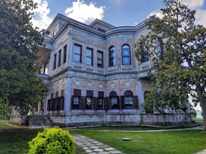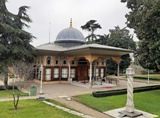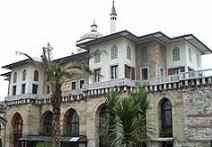
Latest News
New openings
The Zeyrek Cistern is opened to visits after years of restorations.
Entrance fees
As of 2026, Palace museums' entrance fees are raised.
Museum Pass
You can buy the "Museum Pass" for foreigners which is valid for 5 days in various museums of Istanbul.
Museums open 7 days
Many State museums in Istanbul operate 7 days a week, except Topkapi Palace.
Pavilions & Kiosks in Istanbul
Since Istanbul was the capital of the Ottoman Empire, there are several royal kiosks or pavillions in this magnificent city. These kiosks were generally built in the 19th century and used by the sultans as a rest house or a hunting villa. Most of these pavillions have been renovated today and opened to the public as museums or restaurants set in lovely parks and gardens.
Ihlamur Kasri
Ihlamur Kiosk is an imperial rest house built in the middle of Linden trees (Ihlamur in Turkish) in Besiktas district, where you can have a cup of coffee or a cup of Linden tea. The pavilion was built between 1849-1855 by the wish of Sultan Abdulmecit as a resting villa where he also received some of his foreign guests including the French poet Lamartine. It's architect was Nikogos Balyan, a famous imperial architect at that time. Ihlamur Pavilion is formed by two buildings; Merasim kiosk used for ceremonies, and Maiyet kiosk reserved for the court of the sultan or his harem. After the death of sultan Abdulmecit, the pavilion was also used by the sultans Abdulaziz and Mehmet Resat as a relaxing kiosk. It's opened as a museum in 1987.
Open daily between 9:30 a.m. - 4:30 p.m. except Mondays
Phone: (212) 258 50 86
Admission: 280 TL
Maslak Kasri
Maslak Kiosk was the sultan's hunting lodge and a resting place in todays Maslak neighborhood in the new part of Istanbul. The pavilion is a combination of several kiosks built during the reign of Sultan Abdulaziz in the mid-19th century. Kiosks which are survived until our days are; Kasr-i Humayun (imperial kiosk), Mabeyn-i Humayun (imperial court), Limonluk (lemon mansion), Cadir (tent), and Pasalar (generals). The imperial kiosk has the bedroom and working room of Sultan Abdulhamit II. The complex was opened as a museum in 1986 and one of the pavilions now serves as a cafeteria.
Open daily between 9:00 a.m. - 5:00 p.m. except Mondays (Nowadays closed for restorations!).
Tel: (212) 276 10 22
Admission: 280 TL
Kucuksu Kasri

Kucuksu Pavilion was built by Sultan Abdulmecit in mid-19th century at the location known as Bagce-i Goksu on the Asian shores of the Bosphorus, near the Anatolian Fortress. The pavilion was completed in 1857 by the imperial architect Nikogos Balyan. It has three floors including the basement where there were kitchens and storage rooms. Kucuksu was used as a hunting lodge and as a resting mansion by several sultans and restored by Sultan Abdulaziz surviving until our days. The building has a European style in its architecture, rooms and halls are decorated with exquisite fire places made of Italian marble, fine wood parquet floor, European furniture, crystal chandeliers and mirrors with sultans' Tugra, Hereke carpets, paintings etc.
Kucuksu Kasri was used as a state guest house for a short time during the Republic period and than opened as a museum. There is a small cafeteria in the courtyard where you can sit and enjoy the ships passing while sipping your Turkish tea or Turkish coffee.
Open daily between 9:30 a.m. - 4:30 p.m. except Mondays.
Tel: (216) 332 33 03
Admission: 300 TL
Mecidiye Kasri

Mecidiye Pavilion is located in Beykoz district of Istanbul, on the Asian shores of the Bosphorus. It's the first masonry building with new architectural features. The construction of the pavilion began in 1845 by the governor of Egypt, Kavalali Mehmed Ali Pasha, for sultan Abdulmecid and upon his death it was completed in 1854 by his son, Said Pasha. It's built at the top of a grove park with a landscape rising from the sea in various terraces.
In its early years it was used by the sultan as a riding lodge and a summer house, then it was used to receive foreign state officials. During the late Ottoman period it was also used as an orphanage, ophthalmic hospital and childrens' diseases hospital. The pavilion was restored and opened to visitors in 2016. It has breathtaking views of the Bosphorus strait and wonderful furnitures of the period on its two large floors.
The architectural style is typical of 19th century Ottoman period, very western style. Local and imported marbles are used in the façade, as well as timbers inside. It has two floors and symmetrical plan, with a very rich interior decoration and gilded furnitures, fine fabrics, baccarat vases and crystal chandeliers.
Open daily between 9:30 a.m. - 4:30 p.m. except Mondays.
Admission: 300 TL
Aynalikavak Kasri

Aynalikavak Pavilion is located at Haskoy neighborhood on the shores of the Golden Horn. Originally the area was full of agricultural fields during the Byzantine period and than with forests during the Ottoman period, where the sultans built wooden mansions for their relaxation. After the construction of many shipyards, the area has gained importance and the stone made Aynalikavak Pavilion and several other kiosks were built between 18th-19th centuries, and the complex was known by the people as the Shipyard Palaces.
The land façade sits on two floors and the sea-side façade on three. The pavilion has a Divan room and audience hall (Arz Odasi in Turkish) is decorated with sultans' Tugras, fine calligraphy works, nice windows and mirrors. The ceiling is covered with a dome. In the lower floor of the Pavilion there is a research center for traditional old Turkish musical instruments where occasionally Turkish traditional music concerts are being held. The Aynalikavak is opened to the public in 1984 as a museum.
Open daily between 9:30 a.m. - 4:30 p.m. except Mondays.
Tel: (212) 256 97 50
Admission: 280 TL
Sepetciler Kasri

It's located at Sarayburnu area in Eminönü neighborhood, at the entrance of the Golden Horn. The Kiosk was built in the 16th century by Sultan Murat III within the grounds of Topkapi Palace and was renovated by Sultan Mahmud I in 1739. It was also used as a boat house for imperial boats where the sultans used to watch their navy leaving or returning from a campaign. During the Republic era, the Sepetciler Kiosk was used as an army pharmacy and than left empty until its restoration in the late 1980's. Today, a section of the pavilion serves as the International Press Center of the General Directorate of Press, which is not open to the general public.
Tel: (212) 519 18 17
Tophane Kasri
The Tophane Pavilion gets its name from Tophane neighborhood, meaning Cannon factory in Turkish, where there was one. It's located next to the Nusretiye mosque and was one of the most important buildings on the Tophane Square during the Ottoman period. The kiosk was ordered by Sultan Abdulmecid and built by the British architect William James Smith in 1852. It was especially used by the sultans visiting these weapons factories in the neighborhood and also to receive foreign guests coming to the port by the sea, such as the Russian Czar's brother Grand duke Konstantin.
Tophane Kiosk runs parallel to the shore on a rectangle plan built on two floors. It has a European style like all other mansions of the same period, with fine hand work ceiling decorations and marble fireplaces. It is recently restored and re-opened to visitors in 2024. Nearby, there are Istanbul Modern Arts museum, Tophane fountain, Nusretiye mosque, Kilic Ali Pasha mosque, an old Turkish bath, and Cannon factory as sites of interest in this neighborhood.
Hidiv Kasri
Hidiv Pavilion is located on the hills of Cubuklu neighborhood in Beykoz district on the Asian side. It was built in 1907 by Italian architect Delfo Seminati as a residence for the Ottoman governor (Hidiv or Khedive) of Egypt, Abbas Hilmi Pasha. The mansion stands in a large park, at the main entrance there is a monumental fountain rising all the way to the roof which is covered with stain glass. Other fine fountains and pools surround the building. Several rooms and halls are connected to each other on a circle plan, and there is a large hall on the ground floor with a fire place. On the upper floors there are two great bedrooms. The tower is the most popular section of the kiosk because of its view over the Bosphorus, one can access to the terrace on top with an elevator or by using the stairs.
The Hidiv kiosk was sold to the Istanbul Metropolitan Municipality (IBB) in the 1930s and not used until 1980s. After a two year restoration period, Hidiv Kiosk was opened in 1984 as a hotel, restaurant and cafeteria. It's open everyday.
Tel: (216) 413 92 53
Malta Kosku
The Malta Kiosk is located in the Yildiz Park at Besiktas district, near the Yildiz Palace. It was built in the mid-19th century by the Sultan Abdulaziz in this heavily forested park and used as a relaxing mansion for both sultans and their ladies wondering in the nicely cared vegetation. At some periods of the late Ottoman history, the mansion has also witnessed dramatic moments such as isolation or exile of young heirs or princes, Murad V to name one. The kiosk has a European decorative style with Acanthus leaves column capitals, fine friezes on the marble fountain at the entrance, gold leafed mirror, and ceiling decorations with fat marble fish statuettes. The mansion wasn't used much during the Republic era until 1979, than it was restored and opened to the public. Today, there is a restaurant and cafeteria inside which is open everyday.
Tel: (212) 258 94 93
Huber Kosku
Huber Mansion is located at Tarabya neighborhood on the European shores of the Bosphorus. Its exact construction date and architect is unknown but most probably it was built by Italian architect D'Aronco in the 19th century for a German weapons dealer, Mr. Auguste Huber. The mansion was extended with new constructions added at different periods as we can see it today. When Huber family left the mansion during the invasion of Istanbul after World War I, the mansion changed several hands until it was finally expropriated by the Government in 1985 and converted into a Presidential summer residence. Besides the main building, the mansion has a stable, garage, servants house, two small chalets and a greenhouse.
Huber Mansion is a Government property and closed to the public visits.
Note: Please note that admission fees, opening times or days of closure of the museums might be changed without prior notice, or that museum or section might be closed for restorations. To be certain on the closure days or opening times, you can call the museum directly (country code for Turkey is +90) or contact me to double check. Most of the museums have longer opening hours during summer months.
Hope to see you soon in Istanbul.

